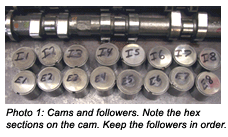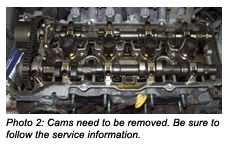With the reliability that late-model cars and especially their engines enjoy, we don’t find ourselves doing too much heavy engine work anymore. Many of us miss the feeling of accomplishment we’d get when completing an in-house engine rebuild. I know I always enjoyed the moment when the fresh engine would light right off and run well.
On the other hand, today’s modern engine doesn’t necessarily lend itself to the types of repairs we did a few years ago. In most cases, it’s simply more efficient to replace a badly damaged engine with a rebuilt or recycled unit, getting the car out of the shop and back to the customer in a timely manner. Lately, the only engine work we seem to be doing is cylinder head gasket replacements. Some of these replacements stem from design issues that show up as the mileage accumulates, but most are the result of overheating.
PINPOINTING THE PROBLEM
Like any repair, the diagnostic process begins at the service counter. Many times, the complaint will be as simple as the heat comes and goes as the car is driven. More serious problems may involve misfire codes being set and the car putting out steam on start-up.
You have a couple of choices when it comes to confirming that the head gasket is the reason for the low coolant level. While taking compression is an important step, only the most severe cases of head gasket leakage will be found using this method. But it will give you a quick indication of the engine condition and help you determine the best strategy for this repair.
Another quick test is a dye test where you draw the air from the cooling system through a liquid that will change color if exhaust gasses are present. This test works well as long as you follow some precautions. The first is to be sure the dye is good; it doesn’t have a long shelf life. The other is to be careful that none of the coolant finds its way into the tester and gives you a false reading. Some guys have had good success using their gas analyzer to look for hydrocarbons coming out of the radiator, but be very careful about the coolant being ingested here.
 We find the most reliable test to be a cylinder leak-down test that rarely misses a problem and gives us the added advantage of knowing which cylinder is leaking. This lets you look more closely at that cylinder for cracks or problems that will affect the success of the repair. The leak-down test also gives the best look at how well the cylinder is sealed from a mechanical perspective.
We find the most reliable test to be a cylinder leak-down test that rarely misses a problem and gives us the added advantage of knowing which cylinder is leaking. This lets you look more closely at that cylinder for cracks or problems that will affect the success of the repair. The leak-down test also gives the best look at how well the cylinder is sealed from a mechanical perspective.
A leak-down test is more labor intensive than the other methods and the customer has to understand the costs involved, but it beats pulling a head off without being sure there’s a problem. This test involves removing the spark plugs and filling the cylinder with compressed air, while monitoring how well the cylinder holds pressure.
 The necessary tools generally have two gauges with one showing the pressure in and the other reading what the cylinder holds. We use 100 pounds as an inlet pressure giving us the percentage of leakage. Of course, the cylinder has to be at TDC on the compression stroke so both valves are closed. This seems to be where most techs struggle when performing this test. I find it easiest to start with the number one cylinder and follow the firing order. While the air is in the cylinder, remove the radiator cap and watch for signs of the air entering the cooling system (be sure the cooling system is full and bled). At the same time, listen at the intake and exhaust for leakage at the valves and the dipstick for an indication of how well the valves and rings are sealing. Like any diagnostic tool, it’s important that you check good cylinders so as not to be fooled by sounds that you’ll hear that are normal. Another tip is to listen in the other cylinders through the plug holes. While the valves are closed in the cylinder, you’re testing that they’re open in the other cylinders, which will allow air escaping from the test cylinder to find its way into the other cylinders by way of the intake or exhaust manifolds.
The necessary tools generally have two gauges with one showing the pressure in and the other reading what the cylinder holds. We use 100 pounds as an inlet pressure giving us the percentage of leakage. Of course, the cylinder has to be at TDC on the compression stroke so both valves are closed. This seems to be where most techs struggle when performing this test. I find it easiest to start with the number one cylinder and follow the firing order. While the air is in the cylinder, remove the radiator cap and watch for signs of the air entering the cooling system (be sure the cooling system is full and bled). At the same time, listen at the intake and exhaust for leakage at the valves and the dipstick for an indication of how well the valves and rings are sealing. Like any diagnostic tool, it’s important that you check good cylinders so as not to be fooled by sounds that you’ll hear that are normal. Another tip is to listen in the other cylinders through the plug holes. While the valves are closed in the cylinder, you’re testing that they’re open in the other cylinders, which will allow air escaping from the test cylinder to find its way into the other cylinders by way of the intake or exhaust manifolds.
This month, we’ll be looking at a 2004 Nissan Sentra that found its way to our shop after recently being serviced, including a coolant change. The customer’s initial complaint was that the heat was coming and going and the temp gauge was fluctuating. The initial inspection showed a low coolant level, after a refill, bleed and pressure test with no leaks found and a five-mile road test. We returned the car and told our customer to let us know if the problem persisted, thinking the system may not have been bled thoroughly when the coolant was changed.
Within a week, the Sentra found its way back, with the customer reporting that the same problem returned. Only this time, he added some coolant to prevent any overheating, but it was clear more intensive testing was in order. The leak-down test resulted in the coolant level rising in the number three cylinder. Although it showed only 5% leakage, it was obvious the head gasket was no longer doing its job.

